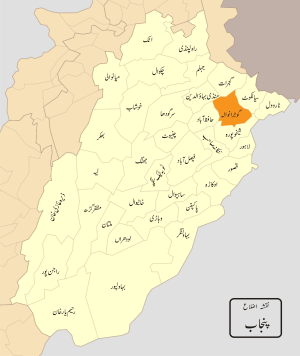Gujranwala District facts for kids
Gujranwala District is a region in the Punjab province of Pakistan. It's like a county, and its main city is Gujranwala, which is also its capital. This area is known for its rich history and culture.
Contents
A Look Back: Gujranwala's History
Gujranwala is a city in the northeast part of Pakistan's Punjab province. It's surrounded by other districts like Sialkot, Sheikhupura, Hafizabad, and Gujrat. The area is part of an old region called Sandal Bar, located between the Chenab and Ravi rivers.
Early Times and Local Rulers
The southern part of Gujranwala District was once known as the Virk territory. Here, the Virk Jatts tribe lived and ruled their land independently. Before the Sikhs arrived, many local Muslim tribes controlled the Gujranwala area. Some places like Gujranwala city, Wazirabad, and Eminabad were under local Sikh rule.
In 1738, a powerful leader named Panah Bhatti had a lot of influence over western Punjab. Gujranwala was also under his control for a while. However, he was later defeated and captured by the Muslim Mughal Governors of Lahore.
The Rise of Sikh Influence
Sardar Amir Singh was an old Sikh leader from Gujranwala. His daughter, Mai Desan, married Sardar Charat Singh Sukerchakia in 1756. Charat Singh came from Amritsar with a large Sikh army. He took control of Gujranwala and set up his own independent state.
Mai Desan and Charat Singh had a son named Sardar Mahan Singh Sukerchakia. Mahan Singh expanded his family's lands and fought against other local tribes. He married Mata Raj Kaur around 1777. Their son, Maharajah Ranjit Singh, was born in 1780 in Gujranwala. He later became a very famous ruler.
From 1792 to 1801, Gujranwala was the capital city for Ranjit Singh. He then captured Lahore in 1799, and it became his new capital. Another important figure, Sardar Hari Singh Nalua, was also born in Gujranwala. He was a great general for the Sikh army and helped rebuild the city of Gujranwala.
Ranjit Singh brought all the independent states in Gujranwala under his rule. He was known for being tolerant of different religions. He even built shrines for Sufi saints, showing respect for local traditions.
British Rule and Partition
In 1848-49, the Second Anglo-Sikh War took place. One important battle was fought at Ram Nagar in Gujranwala, where the Sikhs won. However, by 1847, the British had started to gain influence in the district. By 1849, Gujranwala was fully under British rule.
In 1947, when Pakistan became an independent country, Gujranwala District became part of Pakistan. This was because most of the people living there were Muslims. During this time, many Sikhs and Hindus living in Gujranwala moved to eastern Punjab. At the same time, many Muslim families from different parts of India moved to Pakistan. A large number of these families settled in the Gujranwala region.
Today, Gujranwala is a very populated area. The main tribes and communities living here include Jatts, Rajputs, and Muhajirs (people who moved from India).
How Gujranwala District is Managed
The Gujranwala District is divided into smaller areas called "tehsils." Each tehsil has its own local government to help manage the area. There are four tehsils in Gujranwala District:
Images for kids




